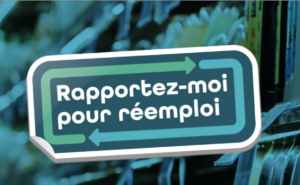To understand the environmental impact of a product, it is essential to conduct an evaluation throughout its entire life cycle: tracing all the steps it goes through, from its creation to its use, and finally to disposal or recycling. This is exactly what the so-called “LCAs” are all about.
LCA stands for Life Cycle Assessment, a method to evaluate and improve the environmental aspects of products, but also services and organisations. This technique is extremely powerful and precise because it considers the entire product life cycle, which features many interlinked stages ranging from the initial raw material extraction until the final disposal at the end of life (Fig. 1). LCAs are widespread in the scientific community, who use this modelling technique to measure and compare environmental performances of different systems. To date, LCAs are increasingly used both by private companies to test the environmental performances of their products and systems, and by institutions and organisations seeking to environmentally improve their policies and actions.

Fig. 1 – Life Cycle Stages
At R3PACK, the LCA methodology has initially been used to assess the environmental impact of existing single-use plastic packaging, as a basis for the comparative analysis of innovative solutions developed within the project, both for the Substitution and Reuse pillars.
LCA analyses therefore compare existing products with the newly developed paper-based packaging solutions, resulting from the research work conducted in the Substitution segment. In parallel, new reusable products and different systems for Reuse will be compared with the current single-use packaging, considering the same food typology and functional unit.
Comparing single-use and reuse from an environmental impact perspective means comparing systems, not only different materials. For this purpose, LCAs together with the logistical and economical aspects will provide useful results to optimise the reuse scenario, especially regarding washing and transportation phases and the eco-design of the packaging at different levels.
From origins to standardisation
The methodology dates back to the 1970s, in which the awareness of environmental issues, together with the urgency of more sustainable development models, became stronger. The first impact assessment studies concerned the production of beverage containers: so, even then, the need to control the impact of such a widespread product as packaging was clear.
However, the term ‘Life Cycle Assessment’ appeared for the first time in the 1990s, when the Society of Environmental Toxicology and Chemistry used it to refer to a structured methodology, very similar to the one still used today. The limitations of this methodology were immediately evident due to, above all, difficulties in comparing different products or systems, as they were analysed with different approaches. To fill this gap, a huge standardisation effort was undertaken to harmonise references and practices. Today, standards number 14044 and 14040 issued by International Standard Organisation (ISO) define the guidelines, requirements, and principles of this methodology.
Further harmonising actions have been taken within the EU context since 2013, when the European Commission proposed the Environmental Footprint method as a common way of measuring the environmental performance of products (goods or services) and organisations. In addition, specific shared Product Category Rules (PCR) for the execution of LCA analyses of specific compartments are increasingly widespread to foster sectorial harmonisation of studies. In 2021 the European Commission issued a recommendation on the use of the Environmental Footprint methods to measure and communicate the life cycle environmental performance of products and organisations that serves as a key reference on the matter.
Another significant point of reference is the European platform on Life Cycle Assessment (LCA), the EU’s knowledge base addressing business and policy needs for sustainable production and consumption. It hosts dedicated webpages for LCA projects conducted by the Joint Research Centre, focusing on specific key sectors and applications. At the global level, the Life Cycle Initiative – hosted by UN Environment – represents a public-private, multistakeholder partnership aimed at facilitating the adoption of reliable life cycle knowledge by both private and public decision-makers.
Despite the efforts in standardisation, in the execution of the analyses there is still room for a range of methodological choices that impact the results.
Phases of an impact assessment analysis
ISO standards define four main stages to carry out a Life Cycle Assessment (Fig. 2):
- Goal and scope definition: In this phase the purpose, scope, functional unit (In-depth box), impact categories to consider, and system boundaries of the study are defined. Not least, the main limitations and assumptions are declared. As LCAs are kinds of “pictures” of products or services impacts, this initial step strongly influences the final results because it defines how these “pictures” are framed.
- Inventory analysis: The second step entails the compilation of an inventory of inputs (e.g., energy, materials, etc.) and outputs (e.g., waste) for the product throughout its life cycle.
- Impact assessment: In this phase, the magnitude and significance of the environmental impacts related to the studied system throughout the product life cycle are evaluated.
- Interpretation: The final stage of an LCA consists of summarising the results of the inventory and impact assessment phases. Conclusions and recommendations are drawn critically considering significant issues emerging from the results.

Fig. 2 – Life Cycle Assessment stages
Functional Unit (FU) concept plays a key role in defining comparisons between products or services. In fact, FU is the reference unit reflecting the function of the studied product and precisely defines the quantitative aspects related the function itself by answering the following questions:

In-depth box – Functional Unit (image retrieved from mase.gov.it; adapted by authors)
Impact categories
During the impact assessment phase (Phase 3) the inventory results (Phase 2) are assigned to their respective impact categories, among those selected in the goal and scope definition (Phase 1). Impact categories may cover a wide range of impacts generated by the product or service on the environment. One of the most well-known regards climate change. Among others, there is acidification, eutrophication, ecotoxicity, land use, water use, and mineral and metal resource use.
The goal of an LCA
An LCA typically implies cumbersome calculations and takes a lot of time due to multiple iterations. But what can be considered, at the end of the day, the ultimate results of this process?
What is important is not just the raw final figures describing each impact category, but rather their critical interpretation which occurs downstream of the analysis: in fact, these data offer decision-makers reliable insights on the actual impacts of the studied product or service, and can inform strategies and actions aimed at avoiding, reducing, or compensating them. Furthermore, the quantitative nature of the impact results allows to clearly visualise the intervention priorities, defining targeted actions to mitigate the most significant impacts.
LCA tools and databases
Today, many softwares to conduct a complete Life Cycle Assessment are available, such as SimaPro, GaBi, openLCA, and Umberto. These computational tools can produce very detailed impact results but require several inventory data on energy and material inputs and known outputs of the analysed system. Not least, to unleash the full potential of these tools trained analysts are needed.
For this reason, simplified LCA tools are becoming increasingly popular since they allow to carry out simple analyses even for those without the skills and resources necessary to set up in-depth ones. An example is the CONAI ECO TOOL, developed to conduct simplified LCAs of packaging and which offers impact results on three indicators: global warming potential, gross energy requirement, and water consumption.
Another complex aspect to address is the environmental data retrieval for life cycle inventory: thus, to support this process, some worldwide recognised databases (e.g., Ecoinvent) are available and offer plenty of datasets.
LCA Advantages & Limits
Life Cycle Assessment features multiple benefits; the main ones are listed below:
- Quantitative results and rigorous method: If properly conducted, LCAs do not entail any subjective judgment, since analyses are rooted in a strongly science-basedapproach.
- Awareness on flows connected to the entire life cycle: LCAs foster choices that are not isolated, but are included in a broader system.
- Prevention of short-sighted decision-making: LCAs consider all environmental impacts and knock-on effects, allowingto identify actions that may have positive effects in the long-term.
Despite being a very powerful tool, LCAs show some limitations that are mainly connected to its complexity:
- Expensive and time consuming: Even a single analysis implies high costs and requires many hours of work.
- Data-intensive: To get reliable results a considerable amount of primary data is required, which is not always easy to retrieve.
- High-level expertise: LCA analysts are highly trained professionals and are rarely present in all companies.
R3PACK – Reduce, Reuse, Rethink PACKaging: towards novel fibre-based packaging and reuse schemes uptake is a project funded by the European Union’s Horizon Europe Research and Innovation Programme under Grant Agreement No 101060806. The project aims to secure the fast and extensive uptake of industrially relevant, cross-sectorial, cost-effective innovative technologies allowing immediate substitution of complex multilayer plastic packaging with high performing fibre-based packaging and economical, industrial and environmental optimisation of reuse schemes demonstrated at large scale and transnationally in three EU countries by two major retailers, covering the needs of 13 different food product types.



